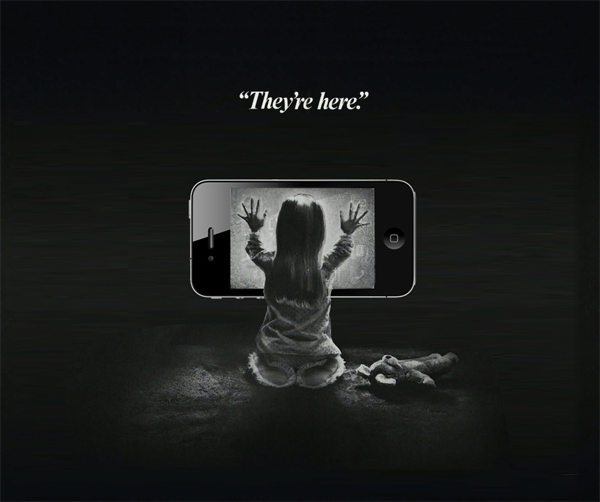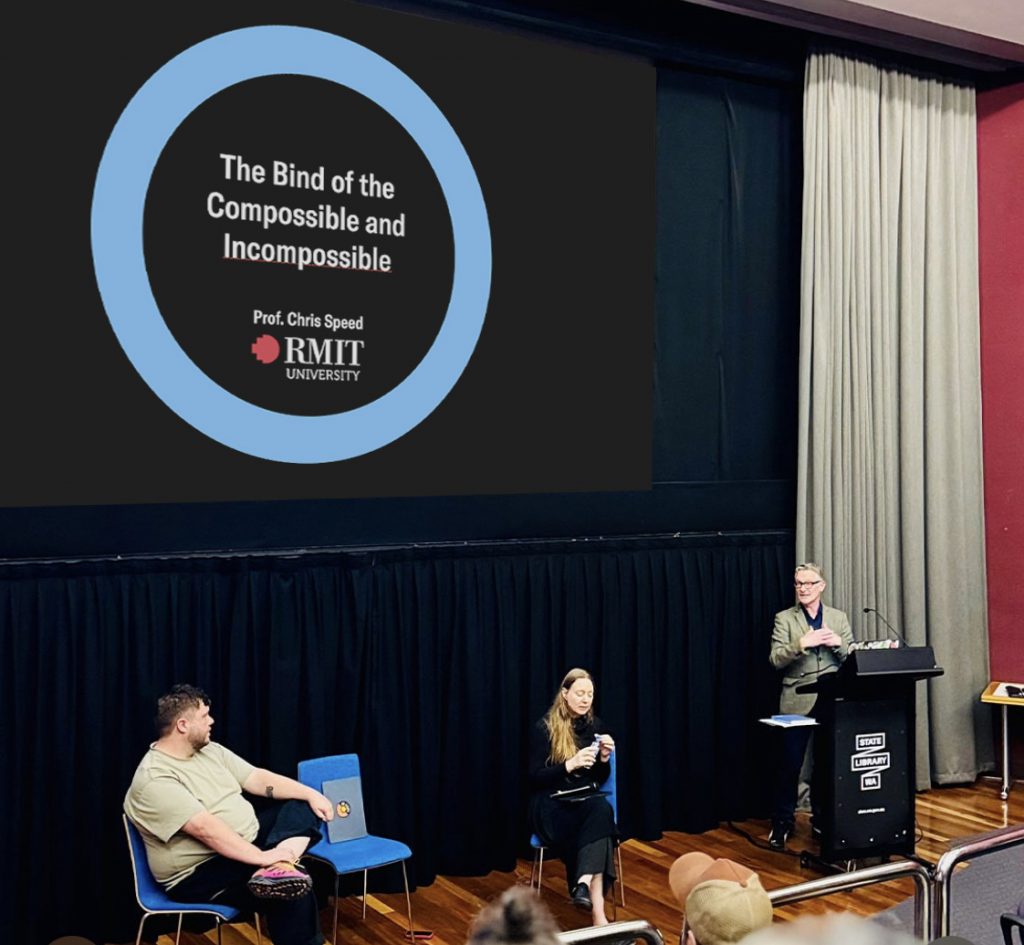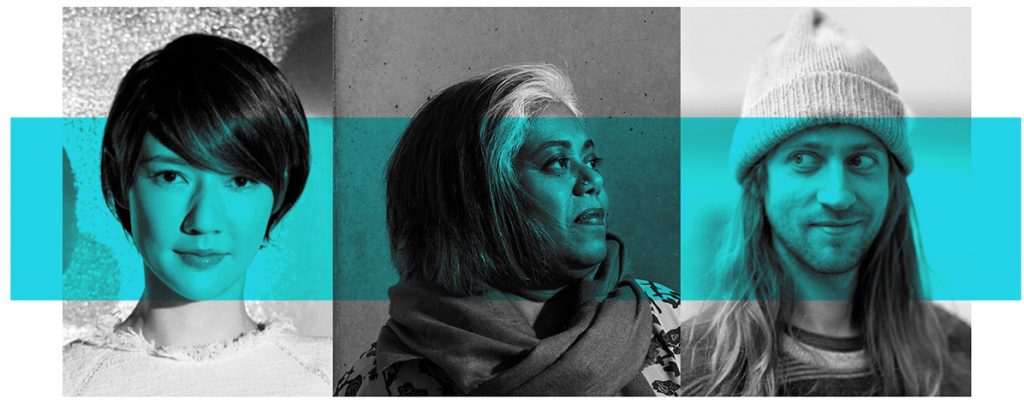Exhuming Spectral Cities
A short essay reflecting on our Walking Through Time iPhone App and the potential for locative media to access social hauntings.

Spectral Cities
Ten years ago, at the Habitus 2000: A Sense of Place conference in Perth, Australia, the cultural geographer Steve Pile articulated the potential for cultural events within cities to bring back the dead and remind us of the past. During his talk, Pile described the occasion of the anti-capitalist march that had taken place on May the 1st in London, and how a series of national monuments had been defaced. Amongst the most memorable was a statue of Winston Churchill being defaced with a strip of grass over his head giving him a Mohican haircut, amongst the many other acts, Pile drew the delegates attention to some graffiti that had been spray painted on to a war memorial (Fig 1.).

He described how two doors had been painted on to the side of the memorial; one with a female symbol and the other with a male denoting that they were in fact toilet doors. Pile went on to describe how the editorials read in the newspapers that featured the images of previous days events and in particular the impact that the toilet doors had had. Whilst the damage to the familiar capitalist targets such as Macdonalds and Starbucks was taken as par for the course, the desecration of a war memorial was a step too far and had stirred the memories of the many thousands of people who had lost their lives during the Second World War. Pile described how the spray painted doors had actually unlocked a passageway to the past, and following their inscription; the ghosts of thousands of soldiers could be ‘seen’ to walk through them into the consciousness of the public who had put aside Remembrance Day until later that year.
Pile constructed a compelling argument for how the use of “ghosts might reveal something about people’s senses of place – about the way affect is woven into the fabric of place; part and parcel of the processes that produce places as places.” (Pile 2004:241).
Developed in to the article ‘Spectral Cities: Where the Repressed Returns and Other Short Stories’ and published in 2004, Pile uses the more complex scenario of a terrorist attack on the headquarters of the British Secret Intelligence Service in London. He uses the violent mortar attack by the Real IRA on the recently completed new building on the Thames and is home to MI6, as a model to describe how ghosts from the past haunt places through acts that don’t have to kill anybody, but are powerful enough to evoke dreadful memories of the past. The MI6 building was a strategic target for the IRA, not because it struck at the heart of anti-terrorist operations (if this was the case, MI5 offices would have been the subject of the attack), but because the ghost could demonstrate their existence by firing upon a high profile building that is in close vicinity of the Houses of Parliament. Slipping away quickly, the ghost’s attack upon the ‘spooks’ was scary enough to remind everybody of the death toll that the IRA’s homeland bombing campaign had inflicted.
“The city haunts, then, because it gathers ghosts both in greater numbers of ghosts and in a wider variety than elsewhere. There is more to it. The city also commemorates those ghosts in more intense ways, in part by making the dead endure in its physical architecture, and in part by juxtaposing the dead and putting them into relation with one another. London, of course, has its fair share of actual memorials, but each new trauma creates a vernacular sacred architecture capable of calling forth the dead.” (ibid:242).
Pile extends his use of ghosts through an analysis of M. Night Shyamalan’s film ‘The Sixth Sense’. For Pile the film demonstrates the social and geographical tensions across time that become embodied within ghosts and sustain memories of trauma’s past. The film centres on a young boy (Cole) who builds a relationship with a child psychologist (Dr. Crowe) who tries to understand Cole’s claims of being able to see the dead. The suspense within the story increases as the identification of who is a ghost and why they should attach themselves to particular places becomes more complex. Children like Cole are used through cinema to tell stories, and often become the conduit through which we connect traumatic events of the past with a haunting in the present. As innocent’s they represent an a-temporal status in society in which time has yet to be formalised into the working day, and days centre around play (particularly through nursery and primary school).
Limited in their ability to read and write, young children have a similar temporal innocence that Thrift proposed for members of communities from the early middle ages when ‘natural rhythms dictate the pace of life and work and the content of language’, and any expectation of a future ‘centres on a short lifespan and the imminence of the Day of Judgment’ (Thrift 1996:180). Holding a position outside of constructed history, children collapse time and space and offer networks through which communication with the dead becomes viable. Whilst Cole in Sixth Sense is able to sustain a position in the present, ghosts use him as a medium through which to relieve their attachment with a place and let them move to the ‘other side’ and become part of history. Understanding Cole as a medium, or an interface to the other times within places, also allows us to understand how delicately poised we all need to be when navigating places of great trauma.
Interfacing with ghosts
But the delicacy of straddling history in order to better understand trauma and perhaps overcome it, is fraught with complexities. In Juan Antonio Bayona’s 2007 film El orfanato (The Orphanage), a child fails to hold the position between the past and present and the house that is haunted by previous events ‘takes him’. The mother, distraught at the apparent loss of her son searches the contemporary ‘space’ of the orphanage in vain for the child. Upon understanding the history of the place, she begins to use memories and rituals of the old building to begin a fresh search across ‘time’. Ultimately, in the most extraordinarily scary scene, she finds that ‘play’ becomes the interface with which to get the attention of the ghosts of the children who occupy the place, and by engaging them in a game of hide and seek she is able to find her own child. However, in order to sustain the relationship with her son who is now part of history, she must remain with him and the other children who were ‘lost’ to the house many years ago, and become a ghost herself. Another classic tale of interfacing with ghosts, and ultimately children is Spielberg’s 1982 film Poltergeist, in which the young Carol Anne begins to talk to ghosts through her parent’s television. Eventually drawn into the ‘other side’ through the TV, like children in El orfanato, it is Carol Anne’s propensity to ‘play’ with an entertainment system that allows it to become the mechanism through which the connection is made.
Of course the contemporary form of television is not a TV-set in the corner of the room that is shackled to broadcast schedules, but laptops and smart phones that are part of a network culture of YouTube videos that allow us to watch television ‘out of time’ such as BBC’s iPlayer or Channel 4’s 4OD. Connected and ‘always-on’, one of the many selling points used by manufacturers and service providers of smart phones is the ability to watch YouTube clips anywhere, echoed in the recent street advertisement ‘You Phone, You Watch, YouTube’ (bus stop poster for the LG KU990 Viewty that allows uploads to YouTube). Having already established the mobile phone as a medium for play with the many games that come ready installed, or the thousands available for download at the press of the keypad, smart phones have become a ‘playful’ interface to transform our experiences as we wait for buses, sit on trains and use them to record events for sharing with others.
Using your iPhone to contact the dead
But just as television has broken away from the constraints of a universal broadcast model of time, and computer gaming has become mobile, maps are now open to many dynamic manipulations to change our experience of a place. The focal point of this paper is a software project that was funded through a JISC (Joint Information Systems Committee) rapid innovation grant that supported the development of a mobile phone application that allows users to overlay a Googlemap of Edinburgh with historical maps. The application ‘Walking Through Time’1 simply allows people to find themselves in a Google map of the present, and select from a long list of old maps and re-locate themselves in a 19th century map of the area.

Retaining the users GPS marker, the moment that the map of the present becomes swapped with a map from the past, the smart phone takes on the properties (albeit limited) of Cole from the Sixth Sense, or the television that drew Carol Anne into the past. The playful interface of the iPhone and our cognitive ability to identify with the blue dot on the screen as ourselves, contests any truth in what we ‘see’ as the city around us, and what is supplemented with the ghosts of buildings that have long since disappeared.
Holding a new users hand, it is a ‘supernatural’ experience beginning to navigate two places simultaneously in which her minds-eye is using the self-identification with the dot on the screen as a proof of herself, and yet finds it (them) located in a place that has changed dramatically around them.
The ability to explore history whilst standing in a live location offers a host of opportunities for user groups to ‘walk’ old streets, discover missing buildings and extend their understanding of the past. Whilst an obvious target of the application may be tourists, the author and developers of the application suggest that many people will choose to navigate their city not in the technologically determined ‘present’ in which the map is as up-to-date and ‘fresh’ as possible, but may prefer to use an old landscape which is occupied by ghosts. Walking through streets that aren’t ‘cleansed’ of memories, or monitored by spooks that want to guide our interpretation of the past in order to sustain our fear of particular ghosts, may help us ‘see’ the trauma that remains in a place and tread with understanding around its scars.
So the mobile phone may have another unexpected capacity: that of being our spirit guide for navigating social and cultural geographies. Unlike Cole, who’s connection with ghosts held him back from playing and consequently displaying the signs of a normal child, perhaps the phone can offer us an interface in which histories can be understood through the hacking of location services. The augmented reality systems, within which the Walking Through Time software can be bracketed, offer many opportunities to interface with ghosts, and the next time that you touch your phone’s screen, think what happened to Carol Anne as she touched her mum and dad’s TV.
Notes:
1. The Walking Through Time web application for mobile phones was funded by a JISC rapid innovation grant. The application is for the city of Edinburgh and was developed collaboratively between Edinburgh College of Art and the University of Edinburgh. Conceptual and Historical Development: Ian Campbell, Chris Speed and Karlyn Sutherland, ESALA, Edinburgh College of Art. Technical Development: Dave Berry, Petra Leimlehner and Peter Pratt, Applications Division, University of Edinburgh. Mapping Support: James Reid, Ben Butchart and Tim Urwin, Edina, University of Edinburgh. The project website is: http://www.walkingthroughtime.co.uk and the iPhone App is available here: http://itunes.apple.com/gb/app/walking-through-time-edinburgh/id381528712?mt=8
Related posts

“This communication is not for you.”
Looking to connect 2 recent events / conversations (as is my want) this time to explore a fundamenta

Design Frequencies: Sharing International Practice in Design Research
Already deep into semester two here. Last semester School of Design RMIT College of Design and Socia

The Labour of the Rejected / “Walk the Plank”
Still playing catchup with so many events. A few weeks ago during hashtag#DIS2025, Mafalda Gamboa an

Design Contradictions
Two projects during Melbourne Design Week with collaborators Michael Dunbar and Liam Fennessy to exp

Paradox of Collaborative Speed
Two events in Melbourne over the past 10 days week revealed a tension across contemporary technology

Slow Materials, Slow Money: Can Design Decelerate?
Two events that I’m trying to tie together to glean some connections. The CHI panel on Regenerativ

From Food Networks to AI Governance
Back to reporting on events in Narme/Melbourne. From Food Networks to AI Governance: Reflections on

Planetary Pedagogies
Following the launch of PlanetaryCivics two weeks ago, this is the second extension to contributions

Space Debris to House Keys
Part 2 of catching up with the weeks of activity in Melbourne through February. From Space Debris to

Measuring our demise
Oh Melbourne, three parallel events that spanned the week: RMIT College of Design and Social Context